Sala delle Asse
The Sala delle Asse (In English: 'room of the tower' or 'room of the wooden boards'), is the location for a wall and ceiling painting in tempera on plaster, of decorated "intertwining plants with fruits and monochromes of roots and rocks", by Leonardo da Vinci, dating from about 1498 and located in the Castello Sforzesco in Milan.
Introduction and history
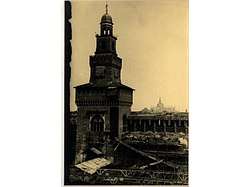
In Milan, within the Sforza Castle,[1] there is an important legacy by Leonardo da Vinci: “Sala delle Asse”, a room with walls painted with a fascinating “trompe l’oeil”, depicting trunks, leaves, fruits, knots, as if it was in open air and not within a castle.[2]
The room was decorated in 1498, as testified by a letter, dated April 21, 1498, to the Duke of Milan, Ludovico Sforza, nicknamed the “Moro” (the “moor”). In the letter […] Gualtiero Bascapè, the duke’s chancellor, states “… Magistro Leonardo promises to finish it by September”.[3] On the 23rd, he writes that “the large chamber is free from the boards”.[4][5]
The current name of the room is ambiguous: some experts state that the name was given since the walls were covered with wooden planks[6] (“Asse” means planks, in Italian). Other experts say that this was a misreading of the letter; with his words, the chancellor was stating a fact (the getting rid of the planks), not giving the name of the room.
Immediately after this letter, in 1499, Milan was taken over by the French army, led by king Louis XII. Over the centuries, several foreign dominations (Spanish, Austrians, ...) followed. The Sforza Castle was used for military purposes: the walls of the room were painted over in white, and its memory was lost.
When Italy was unified (1861) the castle was in full decay, and people discussed about tearing it down. Towards the end of the 19th century the architect Luca Beltrami implemented a plan for restoring the castle, as it can be seen today.[7][8][9][10] Within the restoration, in 1893, some traces of the original paint were detected below the white surface covering the room. Beltrami found the proper financing (mostly from private sources) and selected Ernesto Rusca for a restoration of Sala delle Asse.[11]
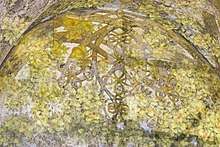
In 1902 stupefied visitors could see the result of this restoration: a wonderful depiction of trunks on the walls, creating a cover of branches and leaves on the ceiling.[12][13] Colors were bright and immediately critics noticed that the “style” did not really look similar to Leonardo's typical style in painting. In addition, the lack of photographic documentation on the room's situation during the restoration raised suspicions.
In 1956, partially to calm the critics down, a second restoration was conducted.[14] Basically, colors were toned down and the room took a more “antique” flavor, which can be seen today.
In 2012, a new restoration started.[15] The main goal was to block deterioration by humidity and other factors. The scientific goal was to further investigate the decoration, uncovering as much as possible of the original work by Leonardo.
This last restoration is ongoing (at December 2018); some important results have already been achieved, including the rediscovery, on the lower parts of the walls, of beautiful black drawings (called “monochrome”) and preliminary sketches.
The decoration of Sala Delle Asse
Pietro Marani (member of the scientific committee for the current restoration), says, about the room: “one is amazed by its spectacular vaulted ceiling, decorated with branches and knots all tangled together: a long rope, weaving together all these branches, is entwined with vegetal elements…”. According to another member of the scientific committee for the current restoration, Maria Teresa Fiorio, “a visitor feels a strong emotion in front of this magnificent example of painted wall decoration by da Vinci.”

What the visitor can see today is mainly due to the first restoration, coordinated by Architect Beltrami, at the beginning of the 20th century. That restoration left the room fully decorated in the vault, with strong trunks on the lateral walls, interrupted by wooden panels. The bright colors used by the restorer (Ernesto Rusca) left puzzled many leading experts of the time, used to the fading colors of the Last Supper. Traces of this restoration can still be seen in a few spots on the vault.
Visitors today see much more somber colors, the result of the second restoration, performed by Ottemi della Rotta in the 1950s. Bright colors did not seem to fit Leonardo da Vinci's style. Experts of the scientific committee still have conflicting opinions about this subject. Wooden panels were still left on the lateral walls.
The greatest part of the decoration on the vault is represented by branches, leaves and berries. The branches and the leaves create the illusion of being in an open space, and not in a room of the castle. The red berries, besides providing charming bright spots of color, are probably an allusion to the Duke of Milan, nicknamed “il Moro”. The mulberries, in fact, in local dialect, were (and still are) called “Moroni”.
Interleaved with the branches, there are ropes and knots. According to Francesca Tasso, vice-president of the scientific committee, “ropes twisting into knots, some of which are extremely complex, constitute a recurring theme in Leonardo da Vinci’s work, during the two decades he spent in Milan”.
After the first restoration, sturdy brown trunks were the departing point for the branches; wooden headboards, with seats for visitors, were hiding the lower parts of these trunks.[16]
During the second restoration (in the 1950s), preparatory drawings in black over white paint were uncovered. Beltrami, during the first restoration, had considered them additions from the 17th century and for this reason, they were covered again, after the second restoration.
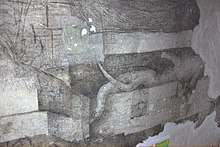
One of the merits of the current restoration is the uncovering of many of these drawings, called “Monochrome” by the experts.[17][18][19] Some of them show the roots of the trees penetrating the side walls and breaking them, with a decorative scheme reminiscent of the decoration of the Palazzo del Te, Mantua. Even more surprising, some other drawings suggest a different solution for the trunks. Cecilia Frosinini, from Opificio delle Pietre dure and member of the scientific committee, says that they suggest “the creation of thin, slanting trunks, springing from the roots and then joining the decoration on the ceiling.”
Current restoration
A new restoration of Sala delle Asse was started in 2012, and is ongoing (as of 2019).[20][21]
The immediate goal is to stop the evident deterioration. In this case, several factors have been identified: humidity from the building, microclimate changes due to negative interaction (chemical binding) between the substances used for the original painting and the material used for the various restorations, accumulation of filth (since artifacts like this can't be cleaned everyday as in a normal house).[22]
The long-term goal is to provide a valid “aesthetic restoration”. First of all, painted surfaces must be cleaned and stabilized. Then the problem of “peeling off” layers due to previous restorations and/or integrating missing spots with new painting (using modern material, such as watercolor, for example) must be faced. There are different opinions about several issues: previous paintings layers (due to restoration) should be totally removed? How much new painting is allowed? Too little, will leave the room in an aesthetically unpleasant state, too much will be somehow a “false”. The scientific committee (see below) is debating the issues, guiding and supervising operations.
Cecilia Frosinini, from “Opificio delle pietre dure”, says[..] “modern restoration must be approached with great humility. It is necessary to appreciate both the original work of the author, and the work of the various restoration experts who followed.”
The restoration of the “monochrome”[17][18][19] is a different story. It was not affected by previous restorations: it was not considered worthwhile and it was covered with wooden planks.
Activities
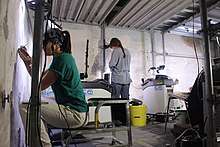
Various activities have been performed since 2012
- Archive digging: relevant documentation has been brought to light or put in the proper perspective. The material included original letters (from the time of the original painting of the room), to historical documentation about the castle, and also about the two previous restorations.[23][24]
- Architectural historical analysis: investigating all the historical events leading to the current situation of the room. Several alteration of the past openings in the room were detected, and properly framed within the history of the castle.
- Technical diagnostics: several modern diagnostic techniques have been used.
- Thermography (detecting differences in temperature on the walls) was used to identify alteration in the building of the rooms (since different materials have different temperatures).
- Laser beams were used to precisely build a 3D model of the room.
- UV fluorescence was used to detect various layers of painting. Ultraviolet light, in fact, can be used to detect the different “organic binders” of paint, i.e. the organic substances (e.g. eggs) used to keep the colors stable. These binders were different from Leonardo time, to later periods and to the previous restorations.
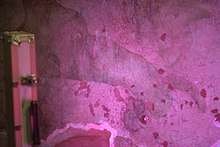 UV fluorescence on the monochrome
UV fluorescence on the monochrome - Spectroscopy (in the Infra-Red range) has been used to detect the various “inorganic binders” used for painting, at various times.
- Artistic analysis: A careful analysis of various documents and results from diagnostics, has allowed to better understand the various events and actions that have brought the castle (in general) and Sala delle Asse (specifically) to the current situation.
- Restoring drawings and paintings
- Careful “peeling off” of layers has allowed to uncover older layers. This has been especially relevant for bringing to light the monochrome,[17][18] currently considered the oldest layer of decoration in the room. It is likely that it was directly due to Leonardo himself.
Scientific committee and restoration operations
The restoration is being conducted by a team of leading experts under the supervision of a prestigious scientific committee:
Claudio A. M. Salsi, Director Area Soprintendenza Castello, Musei Archeologici e Musei Storici (chairman)
Francesca Tasso, Director of the Art Archives (vice-president of the scientific committee)
Michela Palazzo, Restorer at the Polo Museale della Lombardia (works supervisor of the restoration)
Giovanni Agosti, Professor of Modern Art History at the Università degli Studi di Milano
Ermanno Arslan, Academician at the Accademia dei Lincei, and member of the Board of Directors of Italia Nostra Milano
Pinin Brambilla Barcilon, Restorer
Marco Ciatti, Superintendent of Opificio delle Pietre Dure di Firenze
Luisa Cogliati Arano, Member of the Managing Board of Ente Raccolta Vinciana of Milano
Giorgio Sebastiano Di Mauro, Official of the Area Soprintendenza Castello, Musei Archeologici e Musei Storici
Alberto Felici, Curator in the Department for the Restoration of Mural Paintings at Opificio delle Pietre Dure di Firenze
Maria Teresa Fiorio, Vice-president of Ente Raccolta Vinciana of Milan, Professor of Museum Studies at the Università degli Studi di Milano
Cecilia Frosinini, Art Historian– Director of the Department of the Restoration of Mural Paintings at Opificio delle Pietre Dure di Firenze
Larry Keith, Director of Conservation, National Gallery of London
Stefano L’Occaso, Director of Polo Museale della Lombardia
Pietro Marani, President of Ente Raccolta Vinciana, Professor of Modern Art History at the Politecnico di Milano
Marco Minoja, Director of Segretariato Regionale del Ministero dei beni e delle attività culturali e del turismo per la Lombardia
Antonio Paolucci, Formerly Director of the Vatican Museums
Alessandro Rovetta, Professor of Modern Art History at the Università Cattolica del Sacro Cuore di Milano
Antonella Ranaldi, Superintendent of archeologia, belle arti e paesaggio per la città metropolitana di Milano
Luke Syson, Curator in Charge of the Department of European Sculpture and Decorative Arts at the Metropolitan Museum of Art of New York
Actors and Stakeholders
Various stakeholders have made possible the current restoration:
The City of Milan (under the action of the council member Filippo del Corno)
MIBACT (the Italian Ministry for Cultural Heritage)
ALES (a financing agency of the Ministry)
A2A (main private sponsor of the restoration)
Politecnico di Milano (for scientific and technical support).
Following the restoration
It is possible to follow the restoration, “day by day”, connecting to the official website of the restoration
References
- Maria Teresa Fiorio (2005). "Tutto mi piace" : Leonardo e il castello. pp. 163–190. OCLC 887330367.
- Costa, Patrizia (2006). The Sala delle Asse in the Sforza Castle in Milan. OCLC 670255517.
- Nardini, Bruno (2009). Leonardo : portrait of a master. Giunti. ISBN 9788809013506. OCLC 312626908.
- Tasso, Francesca. "La camera grande da le Asse coè da la tore, da Galeazzo Maria Sforza a Luca Beltrami, in Leonardo da Vinci. La sala delle Asse del Castello Sforzesco. La diagnostica e il restauro del Monocromo, Milano, a cura di M. Palazzo, F. Tasso, Cinisello Balsamo 2017, pp. 26-55". Cite journal requires
|journal=(help) - Villata, Edoardo (1999). Leonardo da Vinci : i documenti e le testimonianze contemporanee. Ente raccolta vinciana. OCLC 1000910785.
- Albertario, Marco. "• Documenti per la decorazione del Castello di Milano nell'età di Galeazzo Maria Sforza (1466-1476)". "Solchi", VII, Nn. 1-2.
- Beltrami, Luca (1919). Documenti e memorie riguardanti la vita e le opere di Leonardo da Vinci, in ordine cronologico a cura di Luca Beltrami. Fratelli Treves. OCLC 458406884.
- Beltrami, Luca (1902). Leonardo da Vinci e la sala delle "Asse" nel Castello di Milano. OCLC 636838395.
- Luca Beltrami (1894). Il Castello di Milano '[Castrvm. Portae. Jovis]' so̲tto il Dominio dei Visconti e degli Sforza MCCCLXVIII - MDXXXV con 178 incisioni e 5 tavole. V. Hoepli. OCLC 252280571.
- Beltrami, Luca (1885). Il Castello di Milano sotto il dominio degli Sforza, 1450-1535. OCLC 896626198.
- Frezza, Patrizia Costa. "La Sala delle Asse di Luca Beltrami". Cite journal requires
|journal=(help) - Cremante, Simona (2005). Leonardo da Vinci : [artista, scienziato, inventore] (1st ed.). Firenze: Giunti. ISBN 8809038118. OCLC 162299598.
- Vinci., Leonardo da (cop. 2007). Leonardo da Vinci : 1452-1519 : the complete paintings and drawings. Taschen. ISBN 9783822838273. OCLC 441712538. Check date values in:
|date=(help) - Baroni, Costantino (1955). Tracce pittoriche Leonardesche recuperate al Castello Sforzesco di Milano. Hoepli. OCLC 759078027.
- PALAZZO, MICHELA (2017-07-14). "I restauri dei dipinti murali della Sala delle Asse e delle sale terrene della Corte Ducale nel Castello Sforzesco di Milano". www.politesi.polimi.it. Retrieved 2018-12-19.
- "Teca Digitale". bibdig.museogalileo.it. Retrieved 2018-12-19.
- Michela Palazzo, Studi sul monocromo nella Sala delle Asse e nuove scoperte sull’impostazione compositiva della decorazione di Leonardo da Vinci, in Leonardo da Vinci. Metodi e tecniche per la costruzione della conoscenza, a cura di Pietro C. Marani e Rodolfo Maffeis, Busto Arsizio 2016, pp. 123-132
- Michela Palazzo e Francesca Tasso (a cura di), La sala delle Asse del Castello Sforzesco. Leonardo da Vinci. La diagnostica e il restauro del Monocromo, Cinisello Balsamo 2017
- Francesca Tasso, Lavori in corso: il restauro del monocromo leonardesco al Castello Sforzesco, in Leonardo da Vinci. Metodi e tecniche per la costruzione della conoscenza, a cura di Pietro C. Marani e Rodolfo Maffeis, Busto Arsizio 2016, pp. 117-122
- Michela Palazzo, I restauri dei dipinti murali della Sala delle Asse e delle sale terrene della Corte Ducale nel Castello Sforzesco di Milano, tesi di Dottorato di Ricerca in Conservazione dei Beni Architettonici, Politecnico di Milano, relatore Carolina Di Biase, a.a. 2016-2017
- Claudio Salsi, Il progetto di restauro della Sala delle Asse nel Castello Sforzesco di Milano, in Leonardo da Vinci. Metodi e tecniche per la costruzione della conoscenza, a cura di Pietro C. Marani e Rodolfo Maffeis, Busto Arsizio 2016, pp. 115-116
- www.saladelleassecastello.it http://www.saladelleassecastello.it/narrazioni/en/restorationinthethirdmillenium/. Retrieved 2018-12-19. Missing or empty
|title=(help) - www.saladelleassecastello.it (PDF) http://www.saladelleassecastello.it/wp-content/uploads/2014/09/2013-Paoli_La-Sala-delle-Asse.-Fotografia-e-memoria...-Rassegna.pdf. Retrieved 2018-12-19. Missing or empty
|title=(help) - www.saladelleassecastello.it (PDF) http://www.saladelleassecastello.it/wp-content/uploads/2014/09/2013-Catturini_La-Sala-delle-Asse-di-Luca-Beltrami...-Rassegna.pdf. Retrieved 2018-12-19. Missing or empty
|title=(help)
External links
| Wikimedia Commons has media related to Sala delle Asse. |